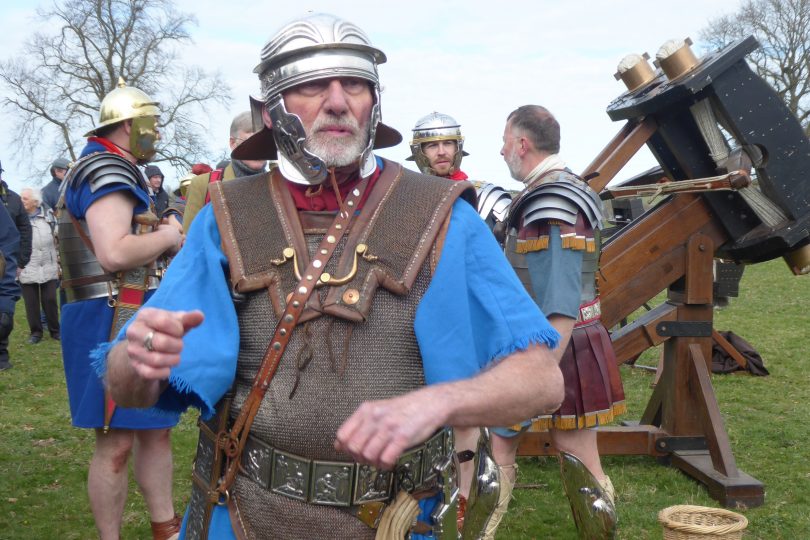The Roman Army School 2019
Note from the Chair:
The 2019 gathering marked the inaugural meeting of the new Roman Army School following the dissolution of the long running Hadrianic Society last year. As such I would like to open this review and round-up of the Roman Army School 2019 with a thank you to everyone who worked hard to ensure the success of the meeting. Your organisers were Linda Davis, Helen Gawthrop, Kim-Marie Coon, John Harding, Steve Huneysett, Graham Pude, and Ron Wood. David Breeze recruited our wonderful lecturers, David Mason opened Binchester Fort for us and the Roman Military Research Society performed the artillery display for us.
We would like to welcome everyone who joined us in Durham this year, a full list of delegates is contained in the final pages of this round-up, along with a full list of lecturers and their topics. This year’s theme was Sieges and Artillery comprising nine lectures and an afternoon excursion to Binchester fort for the aforementioned artillery display. Our aim was to really focus in on Roman siege warfare and weaponry, hence our lectures covered everything from slingshot to besieging Masada.
Dates for next year’s meeting are to be found in the closing pages of this document. A collection of photos from this year’s event can be found on our website (www.ad43.org.uk) I’m off to go start watching some of the films mentioned in Graham Sumner’s lecture.
Also thanks to David Mason, Graham Sumner, Kristian Myer, Christopher Badbury and Ron Wood for the photos.
Best wishes to all,
Susan Porter – Chair

THE ROMAN ARMY SCHOOL 2019 ROUND UP AND REVIEW
Meeting dates Friday 29th March – Monday 1st April 2019
Friday 29th March
Friday was dedicated to arrivals, meet and greet and most importantly the official first opening of the bar. So, with no scheduled lectures, Roman Army Schoolers were able to take advantage of the brilliant afternoon sun and have a look at Durham if they wished or chill out in the Atrium with tea and biscuits. At 17:30 there was a brief introduction to the conference, the Chair, Susan, introduced herself and the team alongside a quick health and safety briefing (you can tell this one is used to doing site inductions, it’s all about the first aid kit and fire plan – ed). David Breeze then explained the theme and aims of this year’s meeting, “Roman artillery and siege warfare”. Our lectures would focus on sieges such as those of Masada and Burnswark, the presence of artillery on the battlefield, slingshot and other projectiles and the research and construction of Roman artillery in conjunction with the live demonstration at Binchester on Sunday afternoon. Dinner was served at 18:30 and many of us could then be found propping up the bar until closing time.
Saturday 30th March
 The first lecture on Saturday was given by Guy Stiebel. This is the first time Guy has spoken at the Roman Army School, but we hope it is not the last. Travelling to us from Tel Aviv University his lecture was entitled, “A Stone Throw … Artillery in Roman Judea”.
The first lecture on Saturday was given by Guy Stiebel. This is the first time Guy has spoken at the Roman Army School, but we hope it is not the last. Travelling to us from Tel Aviv University his lecture was entitled, “A Stone Throw … Artillery in Roman Judea”.
We began by learning of recent discoveries in Akko (Acre) where military equipment, including trident stamped arrowheads, was discovered in layers, indicating the occurrence of more than one siege. Here Guy paused for a moment to consider a slingshot bullet stamped with the letters M.AN. what did this mean? who was MAN? A number of theories were suggested, a long thesis was considered, until ultimately it was recognised that M.AN was likely to be two separate words. What could those be? To cut a long story short M. AN is the abbreviated name of one Marcus Antonius or “Marc Antony” known to be active in the east during the late 1st century BC. This just goes to show that we as archaeologists can often try to read more into the material than there really is. Further inscriptions on sling bullets, such as “ouch” and “I hope you get pregnant from this”, were also briefly discussed, however, Lawrence Keppie was due to give a more detailed discussion on this later in the day.
From Akko, we moved on to Gamla where basalt stone shot, which must have been carved on the site, was found in a pile during excavations. Elsewhere recovered shot has generally been made of limestone and so with this discovery we can conclude that the Romans were producing ballista shot in the field. At this point Guy mentioned a passage from Josephus which recounts a degree of psychological warfare from the Romans. The limestone shot was stark white and could be seen coming, allowing time for warning shouts; “the sun is coming” or “the stone is coming”, depending on your translation of Ha’ben or Ha’even. So, what did the Romans do? They rolled their white limestone shot in ash to blacken it, making it less visible to the defenders.
Guy moved on to, what I think, was the most interesting part of the lecture and informed us of a new discovery at Jerusalem. Located during excavations below a car park (what is it about important archaeological discoveries and car parks recently? – ed), was a thick wall, with scattered shot and spear heads in-situ. Evidence of a Roman siege, but not just any siege, these finds dated to c.AD70 and, as such, are the first direct archaeological evidence that we have of the third wall of Jerusalem and the first Jewish revolt under Titus.
Another wonderful archaeological discovery relating to Roman artillery was made at Masada. Or rather the caves outside Masada, where a spear dating from the siege was found still leaning on the wall. What is fascinating about this discovery is that the spear head is actually a re-used Roman catapult bolt. It has been removed from a fired bolt and re-purposed with the staff to make a spear. The piece is remarkable both for its preservation and as an example of battlefield innovation. In another cave were found two purses, one containing only Roman coinage, the other only Jewish coinage, was this one man hedging his bets as to how things would pan out, or are we looking at two separate lost purses? As ever, sometimes the archaeological remains whilst answering several questions, throw up many more. With a huge amount of food for thought and new discoveries to mull over, the assembled group disbanded for tea, biscuits and discussion of Guy’s lecture.
 The second talk of the day, “Roman Artillery on the battlefield” was given by Roman Army School regular, Jorit Wintjes. We were now getting technical, asking the questions of accuracy, rate of fire, stopping power and the logistics of moving kit. Hence the alternate title of the lecture “Why standing in a muddy field can be enlightening”.
The second talk of the day, “Roman Artillery on the battlefield” was given by Roman Army School regular, Jorit Wintjes. We were now getting technical, asking the questions of accuracy, rate of fire, stopping power and the logistics of moving kit. Hence the alternate title of the lecture “Why standing in a muddy field can be enlightening”.
The group were treated to a short video clip taken in Hamburg of a reconstructed Roman bolt thrower. The range was 120m and the target; 25mm chipboard, 15mm oak beam and 15mm Euro pallet (total of 55mm or 0.55m). The bolt was clearly heard to whistle as it flew through the air and even from a distance was observed to punch a hole clean through the target described above with an energy calculated at c.875 joules. Other attempts at distance firing had reached c.556m.
To get really technical Jorit compared this 857J energy release to that of a .357 magnum (about 750 joule). So, our Roman bolt thrower, at a distance of 120m is equivalent in power to a magnum fired at point blank range, (powerful things these Roman artillery machines – ed). Power of this capability must have been seriously unsettling for any enemy facing these formidable weapons. But how fast was the rate of fire?
The Hamburg demonstration managed short bursts of 4-5 rounds per minute, so would potentially achieve 40 bolts per machine in ten minutes. Vegetius suggests 45-50 bolts per machine and so the reconstructed rate of fire is not far off the recorded Roman rate. This would require a lot of ammunition to be available for the machines.
The next question for discussion is, how were the artillery machines used? Their use is described in literary sources; however, it is usually topical in nature and therefore not precise. It is from Tacitus that we get one of the most important descriptions of the use of Roman artillery, along with evidence for both bolts and stones in pitched battle at the second battle of Bedriacum (Cremona), where a shield piece belonging to the 4th legion was found in a ditch beside the road. Further archaeological evidence for siege and artillery use in battle comes from the Harzhorn battlefield where hundreds of ballista bolts have been uncovered, far more bolt heads than arrow heads. The dating of the artefacts indicates that they come from the reign of Maximinus Thrax in the 230’s AD but we actually have no idea what the Romans were doing there. The distribution of bolts on this site strongly indicates that the artillery could be moved during battle.
To the logistics then. We are aware that in operations light artillery could be used by a three-man crew, whilst heavy artillery required a six-man crew. Totals for each can therefore be estimated as 180 for light and 60 for heavy artillery a total of 240 men of the artillery battalion. To this total we need to add carts and animals, drivers for the carts and ammunition. So perhaps 120 carts, 120 animals, 120 drivers and, maybe 1,000 rounds. A reasonable guess but the logistics of the Roman army are still to an extent largely unclear.
Other questions of course still remain to be answered. For example; if the army has artillery how do they see what they are firing at? Do we need to consider fire control in the Roman army? What about at sea, if we have 100 transports, 20 warships and one flagship how is the battle or landing co-ordinated? On that note, we adjourned for lunch.
Following lunch Guy Stiebel returned for a second lecture, this one entitled, “Masada Shall Not Fall Again? News from the Field”.
Excavations at the Roman siege camps of Masada have yielded some interesting finds. At Camp C, the flint remains of an early construction around the camp contained pottery dated to c.40BCE, the time of the Persian siege. Further excavation work has brought up finds relating to the Jewish revolt of 72/73AD, including a leather covered scutum (shield) painted red, helmet cheek pieces and a very rare piece of scabbard. The Latin name of which, Vagina, was cause of much laughter. There were also fragments of horse harness (reins) which survived along with decoration and a rather impressive wooden phallus (cue more laughter from our filthy minded attendees – ed). The function of such a wooden artefact is unclear; however, Pliny the Elder records that under a Caesarean chariot a wooden phallus was hung to protect the ruler. Could we therefore interpret our wooden phallus at Masada as a protective charm for a wagon? (Is this also why we see similar things hanging on the back of large pick-up trucks on the motorway? – ed). A dump of stone and metal waste outside Camp E provides evidence for production of materials on site.
As for the battle of Masada itself, the western palace was found to contain a huge number of arrowheads, although not as many as at Gamla, where more arrowheads were recovered than are present in the rest of the whole Roman Empire. At Masada, this concentration of arrowheads has been interpreted as a production room for the defenders of Masada. By analysing the recovery of Roman shot, we can see that they targeted the towers, as such we are able to determine both fire lines, and overshoot. The vast majority of Roman shot was targeted along the western section of the city. Ballista balls found on the Roman siege ramp appear to be 2lb shots, designed not for breaking walls, but to keep the heads of the defenders down whilst the Romans pushed forward. New techniques in photogrammetry at Masada have allowed for the volume of stone shot in the walls to be calculated indicating a total of two months of siege.
The famous ramp at Masada, constructed by the Romans to reach the city, is one of the most striking features of the site. However, we learned that the Romans are only responsible for 15% of the ramp, the other 85% being the natural lie of the land. The rock and earth required to build the ramp was simply quarried out of the surrounding area.
The important question to ask though, is why was Masada attacked? And why did the self-killing occur? To understand this, we must really question the myth of Masada and the credibility of Josephus. The Jewish war was over in 71AD, coins were issued with the legend IVDEA CAPTA yet three sites, including Masada were still in revolt. Of these two were squashed in 71, which left Masada alone.
Now, within five years of the capture of Judea 800,000 sestertii had been acquired by the Roman state from the production of balsam, an expensive perfume obtained from this area.
Is this what we are looking at in Judea? Pitched battles in defence of a shrub? A war for money? It’s not impossible. Pliny the Elder records, in reference to Ain Jidy that, “the Jews attempted to destroy this plant as they did with their own lives.” Could it be that this is what we are seeing with the mass suicide at Masada? Can we use Pliny rather than Josephus to understand what really happened when Masada fell? There are so far, no bodies recovered from Masada, however it is known that some of the rebels identified themselves as perfume specialists …
Guy closed the lecture by stressing how important it is to go back and look at the evidence again, look at the contemporary accounts, look at the archaeology and reassess what we may be seeing. It is hoped that Camps A and H will be excavated this year, which may provide further evidence on what really happened at Masada.
 After tea break we kicked off the first of a double lecture session with Lawrence Keppie on “Getting your message across: Inscribed Ballista Balls and Sling Bullets”. The question first and foremost being, just how does one pass a message to the other side?
After tea break we kicked off the first of a double lecture session with Lawrence Keppie on “Getting your message across: Inscribed Ballista Balls and Sling Bullets”. The question first and foremost being, just how does one pass a message to the other side?
There are a few options; we could defect, yell it aloud from the ramparts, (although that could be risky- ed), perhaps a signal? Or a coded message attached to a spear, except that may not be seen. Or we could do what Philip II of Macedon did and put messages, names and other things on our projectiles.
The Romans seem to have picked up this technique during the second Punic War, with the practice reaching a peak during the 1st century BC. Although inscribed slingshot is still in the minority for recovered finds of this period, what we do have carries slogans such as ‘Hit Pompey” and “if you swallow any of this you will sick it all up”.
In terms of archaeological finds relating to Roman projectiles, in Pompeii sling bullets and marks from Ballista shot dating c.90-89BC can be found in the walls, 215 slingshot have been recovered from the town. In Spain, at the site of Calahorra, numerals were found on ballista balls. These do not appear to be linked to weights but may be refer to individual legions or centuries, or perhaps to a ballista machine itself? Two particular ballista balls are of interest from the site though, the first inscribed with the words ‘Castra Martia’ which could mean Camp of Mars or simply relate to military service. A second shot carried a strange inscription, roughly translated as ‘Marcus Lepidus – have fear and scarper’ although the translation is loose and up for debate. As a member of the audience pointed out it must have made sense to those who carved it even if we cannot make it out.
Gaul should offer us a chance to observe a number of battlefields relating to Caesar’s decade of rampaging around, however at Alesia, of the 30 or so sling bullets recovered only 3-4 were actually inscribed. Civil war slingshot bears the legend SCAEV. Whilst at Munda a number of sling bullets were recovered bearing the legend CNMAG for Pompey’s son along with legionary numerals.
In 40BC Octavian defeated Lucius Antonius at Perusine. Archaeology has recovered no evidence of the siege works on the ground, but sling bullets have been recovered from both sides bearing the legionary numerals L.XII SCAEVA and XII VICTRIX and of course, being Romans, a large number carry phallic symbols. Ten of these sling bullets are now in the Ashmolean museum, however many are lost and exist only in 19th century photographs.
Thanks to archaeological finds we are able to track the progress of Agrippa through Gaul, despite there being very little information in the source material about his activities there. But from Narbonne to Bordeaux his route can be reconstructed based on finds of ballista shot and sling bullets carrying his name M. AGRIPPA IMP.
This practice of inscribing bullets continues through Augustus’s reign, although none have been found bearing his name. Uninscribed slingshot have been found in the area of the Varian disaster at Kalkriese, and the practice of inscribing slingshot appears to have died out by the reign of Claudius.
We know of the use of sling bullets, as Caesar records one of his men hit in the face by a Gallic sling bullet, but able to get up and carry on. Caesar further informs us about the use of sling bullets by recounting that his men stopped to make bullets and that the whistle they make flying through the air frightens elephants. In 45BC describing his Spanish War, Caesar twice mentions messages carried by bullets, one apparently detailing the weakness of a town under siege.
But how were these messages on sling bullets meant to be found and read? For the most part the bullets were likely to simply lie unnoticed, so how many times does one have to send the message? Presumably there is a great potential for studying sieges this way if anyone would like to take up the mantle and have a crack at it?
As far as we can tell the inscriptions tend to be the name of the commanding officer, but what of the rude messages? Can we chalk this up to soldiers’ humour? Possibly, at this point Mark Corby spoke up and regaled us with a story of a plane dropping a huge wooden bomb with the word “bomb” painted on it, onto a dummy airfield as a practice. So, are we looking at something similar with some of the examples of Roman shot? Or is it that the soldiers are making their ammo as they go, after all there has only been a single sot recovered from Jerusalem with the M.ANT mark of Mark Antony, so perhaps they were not mass produced for each commander.
This raises another question, if the shot is being made on the road are the moulds reusable? We suspect not, however, this must mean that the army was carrying lead pigs and other things required to create both moulds and shot on the go. Leaving us pondering this point Lawrence ended his lecture and the assembled group made the most of a quick five-minute break in the double session to have a stretch of the legs before returning for the final lecture of the day.
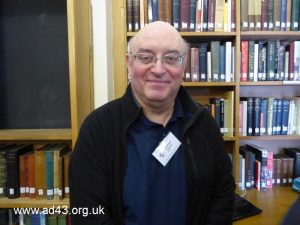
Graham Sumner’s lecture – “Unleash Hell: The Roman Army on Screen”, with over 400 slides and a huge number of films to cover where on earth do I start? Perhaps with Graham’s own words *Caution contains scenes that some experts will find upsetting*. I now have a massive long list of films I need to watch, some of which I’d never heard of and, I’m almost slightly haunted by the idea of Richard Burton in leopard skin. Burton is one of my favourites to play Marc Antony, but somehow, I never noticed the leopard skin outfit.
In a nutshell, what we see with Hollywood Romans is lots of red, red cloaks, red crests red togas, red all around. Emperors always in full armour, Cleopatra always in Egyptian make up. Nymphomaniac Vestal Virgins, slave powered galleys (Ben Hur gave us this one) and the strange semi-circular senate. To name just a few.
The key factor with Roman movies is that they reflect life at time of filming, not ancient Rome. In the films of the 1950’s Quo Vadis etc. the Roman Empire is pagan, decadent and highly sexualised, obsessed with bloody games and fascism. The ruling classes are always English the hero generally American. We should also point out that Peter Ustinov who plays the wonderfully deranged Nero of Quo Vadis was actually once the former chancellor of Durham, where we hold our conference. Does this make us all a Nero in training? We hope not.
These early films were made before archaeological discoveries of Roman equipment had been made, it was not until 1972 that the Ermine Street Guard were able to follow the first publications in creating their armour. And it wasn’t just depicting armour that they had to worry about, in the 1953 film of Shakespeare’s Julius Caesar film makers had to work out how to show a civil war on screen in black and white. The answer was simple, Marc Antony’s forces wore black, Octavian’s white. A similar technique appears to have been employed in the 1963 Cleopatra where Caesar and Octavian’s legionaries wear read tunics and cloaks as traditional Romans whilst Antony’s are in white.
A good number of films re-used old props, for example Ben-Hur utilised costumes from Quo Vadis but made the armour look iron rather than bronze. The Robe generally had better reconstruction and blue tunics, with hybrid helmets. The swords were based on French artillery swords and ideas of medieval swords. The Last Days of Pompeii was the first film to feature the centurion’s transverse crest, however, Peter Connolly was the historical advisor, and so they had an expert on board.
Created 30 years after the major Hollywood epics, Gladiator was no more accurate. At a distance, the whole looks good but bears no resemblance to reality. The scenes are still based on the same Victorian paintings that influenced Quo Vadis and Ben-Hur and the whole was still filmed like a modern war epic similar to Spartacus.
Two later films, Centurion and the Eagle, do a slightly better job with Centurion boasting the best representation of Lorica Segmentata seen on screen. The Eagle had Lindsay Allason-Jones as an advisor and so features good sword belts and weighted pila, however the saddles have stirrups due to the Roman ones being deemed unsafe.
Films covering the later Roman period are rare and later things tend not to look very “Roman”. The 2007 film The Last Legion” whilst making a huge error in casting Mr Darcy (Colin Firth) as a grizzled legionary does have some things right. Likewise, the 2004 King Arthur film, whist showing a well-preserved Hadrian’s Wall gets some things like the chi-ro symbol on shields correct.
Graham went on to talk about different character representation, noting Rex Harrison’s Caesar wearing what essentially looks like a leather jacket and trousers in Cleopatra, whilst poor old Richard Burton is in short skirts and leopard print! In Gladiator too, not only is Commodus depicted as being older than he actually was but Joaquin Phoenix described his costumes as curtains. It’s no wonder the poor character went mad, he wears full armour in every scene, even in his private bedroom, mostly black but sometimes purple, and then there’s that white ensemble at the end, deliberately designed to look like a statue (although I thought it was to better show the blood – ed). We also touched on how the Praetorians are often in black and often the bad guys. The lecture folowed up with a look at how battles and camps are depicted in film before finishing up with a look at what’s ahead. It appears that the praetorians are back in red and transferring to Sci-Fi as they crop up in Star Wars. There is far too much for me to cover adequately here from Graham’s lecture. Really it could fill a book, one that I would certainly find an interesting read. From here we headed to the bar, only to find it full of Roman artillery – more on this later.
Sunday 31st March
Sunday morning’s lectures were given by Alan Wilkins and Len Morgan as a joint venture “Catapult Research 1771-2019” and fascinating it was too.
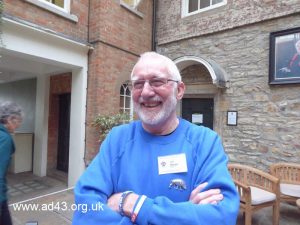

Scholarly attempts to reconstruct Roman artillery began in 1771 when William Newton published the first translation into English of the first five books of Vitruvius. He commented on how hard it was to make sense of the ancient text. Vitruvius does not include all the dimensions or tell us what the machines looked like. The manuscripts are in a poor state and
are mostly 10th century copies. The numerals in them have been misread, corrupted, or entered in error by copyists. In 1781 Newton published impressive drawings of what he believed Vitruvius’ catapults looked like.
In 1840 Guillaume-Henri Dufour published drawings of his versions of Roman artillery. The size of the large rock projectile he envisaged for the ballista was unrealistic.
From 1853 onwards Herman Kӧchly and Friedrich Rűstow produced editions of most of the Greek writers on technical and military subjects, and were the first to understand the special design of the two separate spring-frames of the ballista. They considered its angle of fire to be 45 degrees, but never built their reconstruction. The reconstruction in Mussolini’s Museum at EUR reveals that Kӧchly and Rűstow’s idea was unworkable.
The Musée Nationale at St. Germain-en-Laye was built by Napoleon III to house the national collections of archaeological objects of Gallic, Greek and Phoenician origin. It also housed the first ever working reconstructions of Roman catapults, built by General Verchère de Reffye on the orders of the Emperor. His large bolt-shooting catapult was displayed to the public, and made use of the authentic depiction of this type of catapult on the tombstone of Vedennius Moderatus, an engineer in charge of Vespasian and Domitian’s arsenal in Rome.
As a result his reconstruction is remarkably accurate. In 1851 Napoleon inaugurated excavations at Alésia under the control of Eugène Stoffel.
In 1910 Erwin Schramm published his reconstructions of several types of catapult; he also used the catapult relief on Vedennius’ tombstone for inspiration, and by 1918 had managed to reconstruct every machine mentioned in the Greek and Roman texts as a model or full-scale working machine. Archaeological discoveries of finds of actual parts then began to appear. In 1912 at Ampurias in Spain the discovery of the almost complete metal plating of the frame of a bolt-shooter allowed Schramm to build an authentic reconstruction. Unfortunately he was misled, because the curved front of the frame was hidden from view by the sand tray on which it was displayed in the Barcelona Museum, and so he constructed his replica with a flat frontal frame. Len has been able to build a correct version. The complete metal plating of a second Spanish frame was discovered at Caminreal in the 1980s.
In 1999 at Xanten in North West Germany a bolt-shooting catapult frame was discovered by accident by a JCB scooping out a new sports lake. The piece is virtually complete, but the Romans had cut off the stock. The recovered frame looks identical to that on the tombstone of Vedennius.
We were briefly handed over to Len, because the process of building actual reconstructions has given us improved answers to how the catapults worked. Having built fully-working catapults Len was better equipped to explain many details. Vitruvius suggests mortise and tenon joints, but on the Xanten catapult we see finger joints, with the metalwork locking them into place. The power of this catapult negates any idea of it being a hand-loaded crossbow. A windlass is required to wind it up.
In the 1860’s Victor Prou and A.J.H. Vincent attempted the first reconstruction of Heron’s description of a metal frame bolt-shooter, the cheiroballistra, although they disagreed on how it produced its power. Vincent proposed compressed air. However it was Prou who pushed forward with metal spring power instead. It was also Prou who came up with the idea of inward swinging arms, suggesting that this is what the same type of catapult on Trajan’s Column had. Although Trajan’s Column does not show arms, it is clear that these machines must have had them, perhaps the arms were only painted on rather than sculptured and have been lost to time?
Philon of Byzantium describes a Greek semi-automatic catapult, the size of a small Scorpion. Alan has built a working reconstruction. (anyone else really love the idea of Romans with semi-auto’s or is it just me? – ed).
Heron records the cheiroballistra (“hand catapult”) as comprising eight parts, all beginning with kappa, the Greek letter K. Some experts felt that it was unclear whether he was describing a single piece of equipment or eight! In 1906 Rudolf Schneider dismissed it as a description of a catapult, believing it to be pages torn from an alphabetical technical lexicon.
After a coffee break we continued with a history of the invention of artillery, beginning with Len waving around a large piece of equipment known as a “belly bow”. This could shoot further than an ordinary bow, and was probably first developed by engineers working for Dionysus of Syracuse in 399 BC. In about 350 BC Philip of Macedon invested money into attempting to discover an even greater source of power: his engineers appear to have invented torsion artillery, using two separate bow arms inserted into skeins of highly stretched and twisted ropes. The Roman wood and metal frame bolt-shooters are not likely to be much different to those used by Philip and his son Alexander.
Eric Marsden (1926-1975) spent 25 years working on Greek and Roman artillery, including 15 years producing his two artillery volumes. In the Second World War he had served in the Royal Artillery on 25 pounder guns. He was deeply interested in other aspects of Greek and Roman technology, and before his early death said that he intended to spend some 15 years on these, before returning to the subject of artillery, attempting fresh reconstructions of the catapults and correcting and revising his book.
The discovery at Xanten proved that his assessment of the critical dimensions of the rope-springs was correct.
In 1991 Alan’s reconstruction was put on permanent display in Tullie House Museum, Carlisle. Aitor Iriarte challenged his version, insisting against the mss evidence that the tenons of the cross pieces should be fitted through the pi-brackets of the two field-frames containing the ropes. Finds recovered from various sites indicate a variance in the pi- brackets, and no indication of how to lock the catapult’s parts together. There are no signs of holes in the field-frames’ rings save for those used to adjust the torsion (twist) of the rope-springs. So how did it work? Alan has suggested that he missing parts are bronze locking rings, and told us that he managed to ruin all his dad’s chisels trying to find out answers.
This is where Len as a trained engineering pattern maker comes in: he is able to take Alan’s
work and turn it into fully-powered reality with the correct bronze components.. The question remains, do the cheiroballistra’s arms swing inwards or outwards? Trajan’s Column
doesn’t seem to show arms on the artillery, so are they therefore inside the frames? Both Heron and Philon stress long range and power as the quest for the perfect catapult. Alan indicated that the apparent advantage of inward-swinging arms to produce power is heavily reduced by their geometry. So Len and Tom Feeley built quarter-scale models based on the Hatra frame, and tested them. The results were: Hatra out-swinger: 82m, launching a 90gm bolt, 52.5m with a 94gm ball. Hatra in-swinger: 67m with a similar bolt, 47.6m with the same ball. Vitruvian ballista: 40.6m with the bolt, 35.7m with the ball.
The shortened in-swinging arms acted as shortened levers, making it extremely difficult to wind the arms back the claimed extra 20-30 degrees, and markedly reducing the speed of launching the missiles. Both Arrian and Hadrian emphasise that it is the sheer volume of missiles in the air that will defeat an enemy.
We then looked at a replica of the one of the bolts found at Dura Europos, the only bolts whose wooden shafts have survived. Their iron heads appear to be similar to the bolt heads at Hod Hill and in the spine of the skeleton at Maiden Castle (recently incorrectly reported as the head of a British spear). David Sim assessed Roman bolt heads from all over the empire and concluded that they must be the result of mass production from rolled iron sheets, because they vary in thickness by only one tenth of a millimetre. The sheets may have been imported from China or India.
Importantly, practical tests have proved that the cheiroballistra is portable. At Leiden In 1994 Len carried the catapult and Alan the stand and missiles for 1km, both wearing full Roman kit.
What we need to do now is to intensify our search for more catapult parts. Some may already exist in museum stores. Each discovery could shed new light on Roman catapults, and may offer answers to the many problems faced when attempting to reconstruct them.
The excursion
The afternoon found the Roman Army School embarking on a short bus tour in Binchester Fort, which had been opened specially for our visit. David Mason was on hand to give us a condensed tour of the site including the recent excavation areas. It was amazing to see the depth to which the archaeological remains of the fort survive. He also introduced us to Claudius, the longest serving member to the team who lives in the reconstructed bath house and once went missing (out on the lash with the students we suppose as he turned up in a ditch by the site entrance a few weeks later).
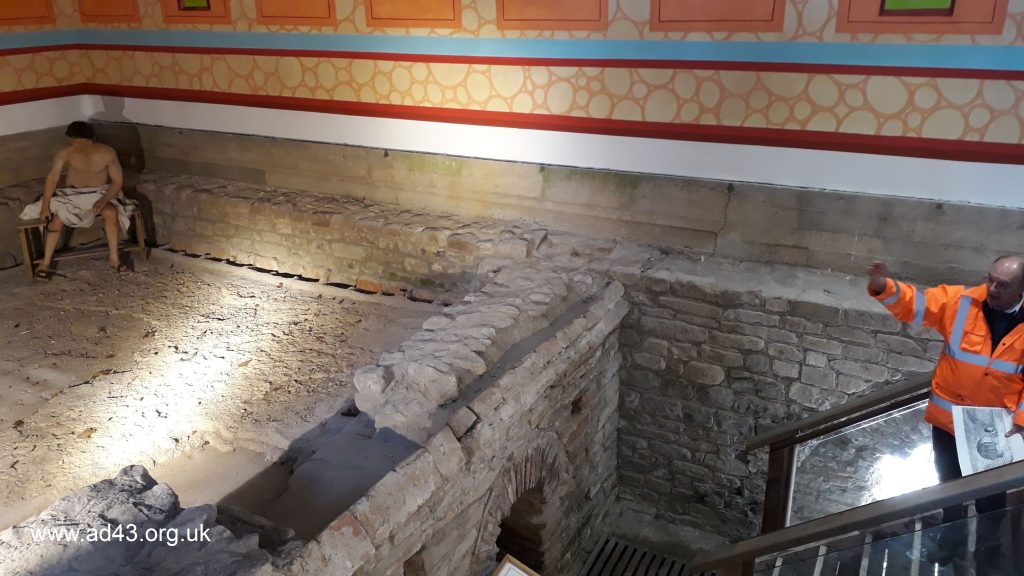
After the tour, we filed excitedly across the grass where a surprising number of Roman Artillery machines were set up, attended to by a number of Roman soldiers, the Roman Military Research Society. They ushered us towards where a Vitruvian Ballista lay in pieces with the tantalising promise that we would be able to see just how portable these pieces were. True enough within the space of three minutes it was looking good, the pieces fitted together and were easily (to our eyes at least) assembled. Then came the fun part, the whole towering piece was tipped forwards to affix the front plate, then 4.30 mins after beginning the assembly the ballista was rocked back and the shot produced.
On the horizon, some 50m distant stood a band of marauding Picts for our target practice. (it should be pointed out that these were not real Picts, it seems that no matter how enthusiastic or professional Roman re-enactors are, health and safety does not allow live targets – nor does it allow real shot – ed). Our ammunition? A grapefruit, turns out our Vitruvian ballista makes a mean juicer. The loading was watched carefully and then with a twang and a crack the grapefruit was unleashed. Some of the assembled were subject to grapefruit spray (the blood of our enemy? – ed) as the fruit exploded on impact, but it did not deter, and a second grapefruit was duly launched. Along with it a story as to why frozen grapefruit is no longer allowed. Turns out that whilst demonstrating missile shot across the Thames one day our friendly team had managed to score a direct hit on a boat with said frozen fruit, Clang!
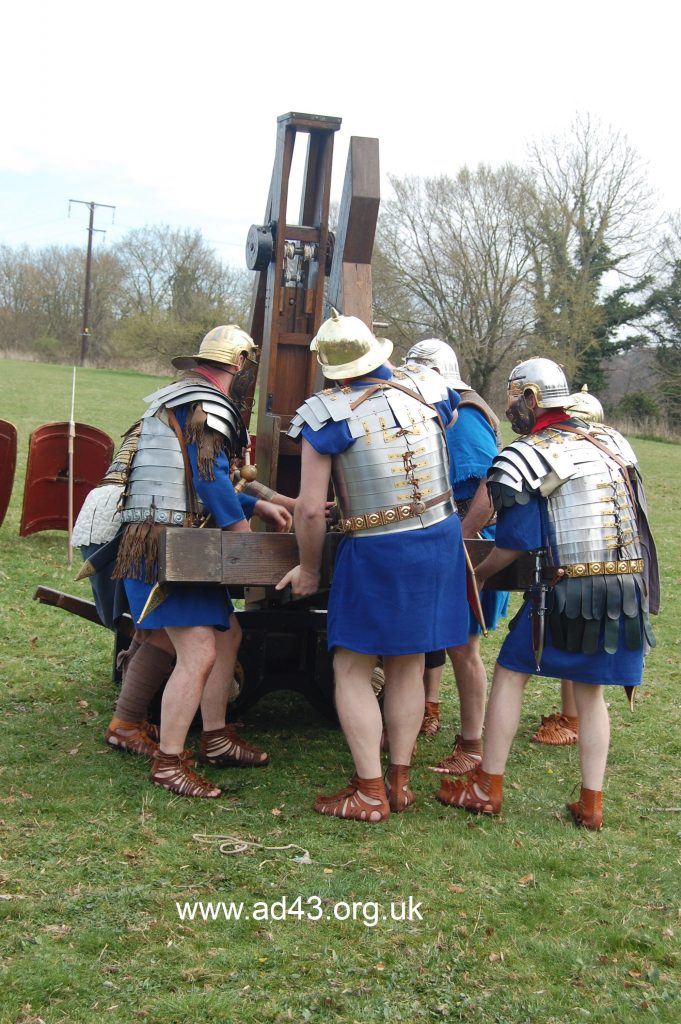
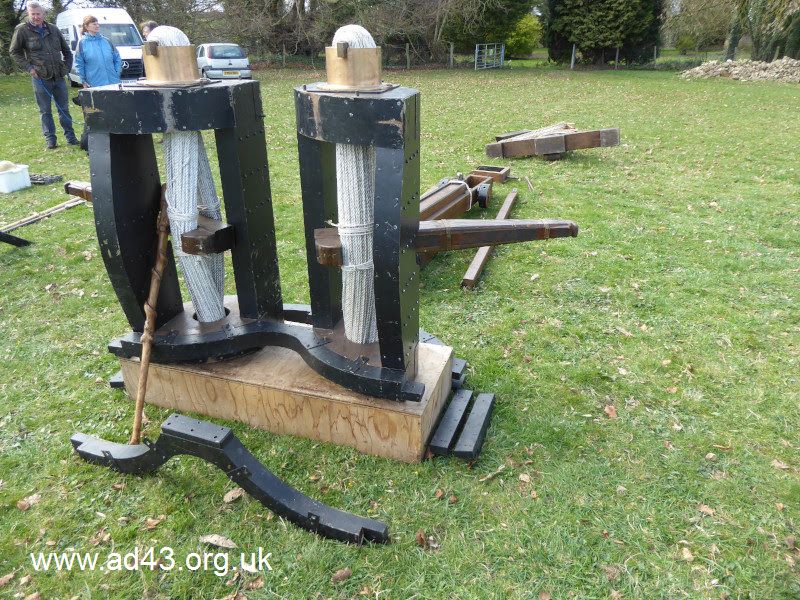
Credit to Kristian Myer for the awesome action shot of the launched grapefruit below.
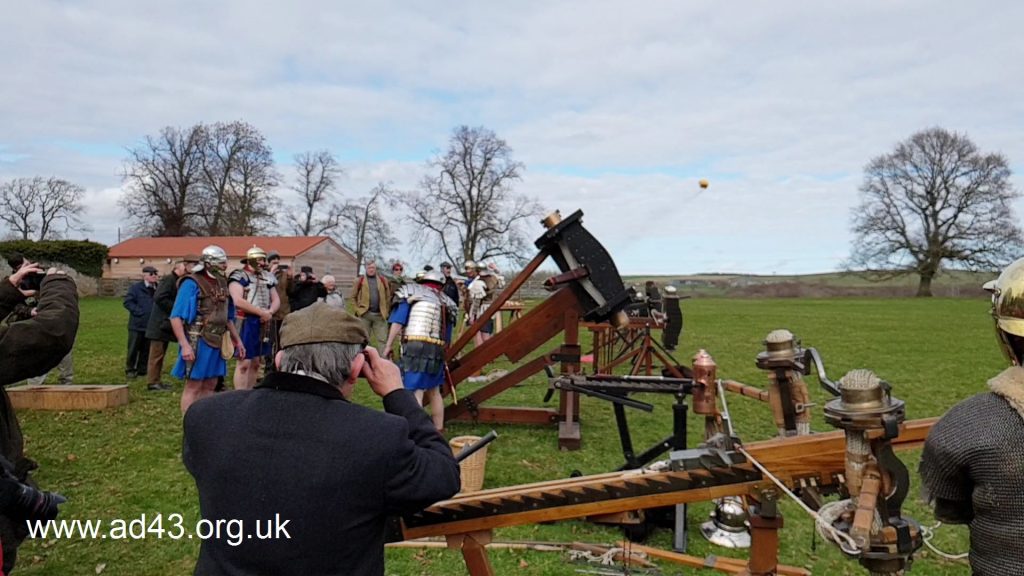
The big machine now spent, we turned our attention to the bolt throwers, intending to begin with the stomach bow, however Alan and Len’s earlier warnings about the equipment were proved true as we were able to witness first-hand, a snapped bow string. So that was the stomach bow out. We moved swiftly on to one of the bolt throwers, all set up and ready to go. All that was needed was for the arms to be cranked back. There was a slight groan and a very loud snap as one of the arms sheared clear off, giving Len a hefty thwack in the ribs as it went. Turns out that the bolt throwers were dangerous to their Roman operators too. However, the team were undeterred, they had more bolt throwers. And a rather skilled archer who seemed content to stand at one end of the line and fire arrows without mishap.
Those of us who witnessed the arm break were actually fascinated by it, to see the inadvertent release of energy, and to see what must have occurred at least once in each artillery engagement was just as exciting as seeing the missiles fired.
Two smaller scorpions at the other end of the line-up were in good working order and demonstrated the two winching/crank systems that Alan had talked about that morning. We watched a demonstration in speed and skill as both were winched back together and fired. To see the team able to lift the rear part of the bolt throwers in order to pivot and accurately take aim was amazing. And the distance achieved by the bolts, truly astounding.
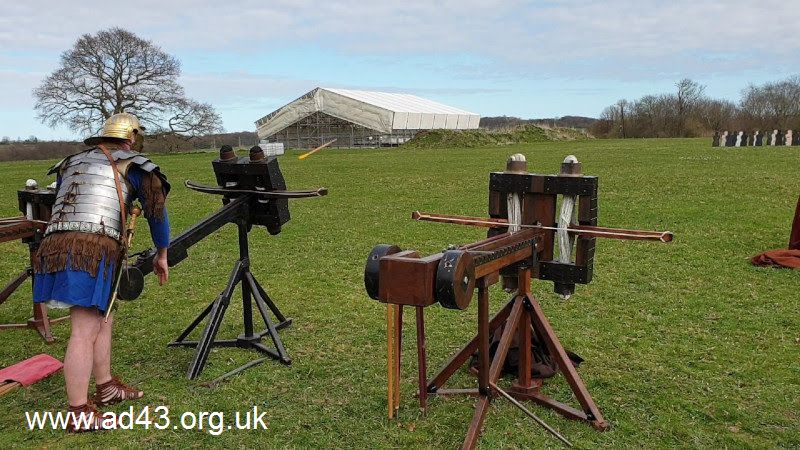
Once the display was over the group were invited to come closer and get a good look at the replicas. One of the replicas with inward swinging arms was on display and one of the demonstrators kindly showed us how it would work. This being opposite to the outward swinging arms where the shot is loaded safely, low down and behind the weapon. To load a full-sized version of the in swinger would require a stepladder and nerves of steel as one climbed it with their back to the enemy to load the shot, which would then for a moment be pointed at the loader’s face. Not inspiring, looked good though. All in all, a fantastic display which I know many of our guests enjoyed. One of the most interesting thing we learned was that the bolt throwers have no recoil. Impressive.
A little chilly in the wind and buzzing with our experience we headed back to the bus, which had inexplicably broken down leaving us with time to kick our heels and people to read the new books that they had bought from the small shop at the fort. We arrived back just in time for dinner and the bar afterwards was once again full of people examining the artillery on display there, although this time through new eyes having seen some of the machines in action.
Monday 1st April
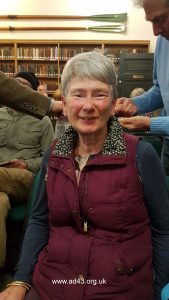 The final day began with a short lecture from Val Maxfield on “Vespasian in Britain”. Here we focussed on the activities of the military legate (later Roman Emperor) during the initial years following the invasion of Britain. Vespasian was legionary Legate to the Second Legion Augusta (Macro and Cato’s legion for those who read Scarrow – ed), he is recorded as victorious in 30 battles conquering 2 peoples, 20 oppida and the island of Vectis (Isle of Wight). But this morning we were looking at the potential for Roman use of Iron Age hillforts as briefly occupied military settlements with a focus on Hod Hill and Maiden Castle.
The final day began with a short lecture from Val Maxfield on “Vespasian in Britain”. Here we focussed on the activities of the military legate (later Roman Emperor) during the initial years following the invasion of Britain. Vespasian was legionary Legate to the Second Legion Augusta (Macro and Cato’s legion for those who read Scarrow – ed), he is recorded as victorious in 30 battles conquering 2 peoples, 20 oppida and the island of Vectis (Isle of Wight). But this morning we were looking at the potential for Roman use of Iron Age hillforts as briefly occupied military settlements with a focus on Hod Hill and Maiden Castle.
At Hod Hill the Roman fort occupies the corner of the hill fort located on undulating ground with a steep approach to the west side, it was excavated by Richmond, going off geophysics results from the University of Bournemouth which indicated good results for a settlement.
The excavation focussed on enclosures and ring ditches within the hill fort where a large number of Roman bolt heads were found around the entrance to a structure dubbed the “chieftains hut”. It was suggested that the Roman artillery was mounted on a siege engine as the hut cannot be seen from downhill of the hill fort. Alan Wilkins interjected here to suggest that the Roman artillery may have already been on the ramparts via planks across the ditches rather than mounted on a siege tower.
The Roman fort was later constructed in the corner of the earlier hill fort, utilising the existing ramparts and closing off the corner. The new Roman gates have traverses along with the wood and earth ramparts with the potential for artillery platforms to exist on the gates. The question is why? The hill fort was taken, is this an example of Romans practising with their artillery?
We moved on to look at Maiden Castle, a hill fort prominent by artifice rather than height of the hill. The enormous defences and west entrance horn-works are probably the most recognisable feature of this hill fort, but is the multi-vallation a symbol of prestige or is it a clue to the increasing use of slingshot and an attempt to outsize range?
During excavation of Maiden Castle Wheeler recovered a hoard of over 20,000 sling bullets and by the east gate, the famous ‘war cemetery’ was excavated, which revealed graphic evidence for the use of sling and other artillery. Sling shot were found embedded in the outworks of the gateway and one of the recovered skeletons had a Roman bolt head clearly lodged in its spine.
Of the 52 burials recovered at Maiden Castle over a dozen indicate signs of damage, such as bolt holes in the skull and examples of healed blunt force trauma. At Spetisbury 130 skeletons also show damage inflicted by Roman artillery fire.
There was much more that could be said and much, much more evidence to look at and assess, but time marched on and with a short break it was onto the second lecture of the morning as David Breeze endeavoured to convince us that the mysterious site of Burnswark is a training camp rather than a real siege episode.

The site of Burnswark is a scheduled monument comprising a flat-topped hill visible for miles around. Primarily a prehistoric settlement, there are two Roman siege camps present on the site and a later medieval settlement.
The key issue with Burnswark is that is appears to have been abandoned by the time the Romans arrive. It is certain that the ramparts had been denuded but people may still have lived on the hill as we have examples of second century pottery and a little material for later periods. Essentially people were living there but it had been abandoned as a hillfort.
In the south camp evidence was found for occupation (more than temporary) and stone platforms appear to have been laid. This has been interpreted as an Antonine fortlet, however there is also suggestion that it may be a square Iron Age enclosure. If this is the case then the stone platforms may also be argued as a misinterpretation. The stone bedrock was reached at the base of the ditches; therefore, it is logical that stone removed from the base of the ditch would be present at the top of the ramparts.
Excavations started work on the west gate and moved onto the next, finding this mysterious paving there too with slingshot bullets beneath. Therefore, it was argued that these platforms were laid out deliberately as targets to practise slingshot accuracy. Shot was found all along this side of the site supporting the theory.
So, the question is ‘Are you pro-Roman or Pro-Caledonian? The preference of the interpreter changes the interpretation.
The south camp lies on the slope of the hill fort. The artillery platform mounds are massive but are in the wrong place to fire at the top, plus they lie external to the camp. This is odd, as no attacking force would leave their artillery in such an unprotected position.
No other site in Roman Britain has evidence for a Roman siege except for Burnswark and here we have to ask why? What are they besieging? An abandoned hill fort, what is the point? Or is Burnswark a training camp. We know that the Romans built practice camps, is there any reason why they may not have built practice siege works?
There are two camps, one on each side of the hill with different types of gate. Originally it was thought that two types of slingshot had been recovered but we now identify six distinct types of shot, which could be read as a stronger evidence for training. Strangely though, we only have one catapult bolt, the normal weapon of siege, from the site.
There seem to be two distinct phases of occupation indicated by this slingshot, but what is it all for? Are the Romans really using a sledgehammer to crack a nut? Surely if this was the site of a real siege then the camps are too close?
Lawrence Keppie disagrees, and outlines that this was most likely a real siege. At Velsen five types of sling bullets were used and across several other sites are examples of 3-4 types of sling bullets, therefore the variable is not indicative of a practice siege.
o preserve democracy a people’s vote was held, with the exception of Lawrence Keppie and Jorit Wintjes the group appeared swayed by David’s assertion that this was a practice camp. But based on the evidence, this writer would suggest that, as noted above, the personal slant of the interpreter changes the interpretation – a fundamental problem we have in archaeological analysis, but that’s another story for another day.
To round-up this year’s meeting we had an open discussion session. There were far too many questions for me to fit them all in here, but I’ve chosen a few that seemed appropriate to summarise the session.
Q: David Lakin asked about defensive artillery in 4th century and naval context, did we not cover it at this year’s Roman Army School due to a lack of evidence?
A: David Breeze explained that a lack of evidence was not the case and that RAS had chosen simply to put the focus on sieges, however David Lakin is correct in that we could have looked at other 4th century and naval warfare. Jorit Wintjes expanded on this as there is literary evidence for naval artillery. When Caesar invaded Britain he wrote it all down in detail so we can read about the naval gunfire support and tactic stats. Germanicus also mounted artillery on ships therefore clearly the Romans were aware of the potential for naval artillery support. – it is entirely possible that Jorit could fill a whole weekend dedicated to this very subject!
Q: Kurt Kleeman asked if there was evidence on Hadrian’s Wall for slingshots/ sling bolts.
A: David Breeze responded that there is very little evidence for weapons on Hadrian’s Wall at all, but perhaps there was artillery stationed on the top of the towers? We don’t actually know what the top of the Wall looked like so it must be a possibility. The Antonine Wall has six platforms that could be for artillery, but were most likely for signalling.
Q: Mike King-Macdona posed the question, if there is no evidence for siege works at oppida in Britain, did that indicate that they were taken by storm rather than seige?
A: Jorit suggested that we shouldn’t expect artillery to leave traces as the machines can be moved around and bolts etc. might be collected, whereupon the group began laughing at the idea of cartoon Romans running around with a catapult. Jorit clarified that his meaning was that the large machines were indeed mobile as had been seen in Sunday’s artillery demonstration.
Q: Geoff Millar asked, why the forts were moved to Hadrian’s Wall from the Stanegate.
A: David responded “good question”. Was it that Hadrian realised Trajan had over extended the empire? Do the frontier walls relate to that? Under Trajan we see the first earthen banks in Germany and numeri units to boost the army. A case of closing down one issue to deal with another? Claudius does something similar in order to allow for the invasion of Britain.
So why the forts on the wall? Perhaps simply that the wall is now in the way so moving the forts is logical to enable access?
Nick Elsden suggested that part of the problem we have in understanding, is that we are only looking at the Wall as a military structure, could it be a political statement or raiding deterrent, is it protecting the movement of civilians? All are valid interpretations.
The topic for next year was discussed, we plan on looking at Romans forts in terms of layout and function, to which Mark Corby had the best response, comparing the inside of Roman Forts to a centrally heated, comfortable spa.
And with that thought I bid you farewell until next time.
ANECDOTES FROM THE BAR (or what happens when lecturers are plied with beer)
I have a little trouble recalling conversations from the bar this year, possibly as a result of too much of the ale,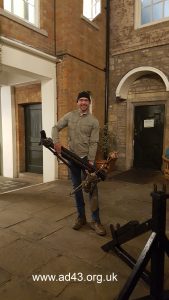 or perhaps because as Chair I was responsibly trying to make sure I did actually speak to everyone and as a result spent very little time with each group? I suspect the first, given that I was one of the last out of the bar each night. Although it may have been that there was an array of Roman artillery on display in the bar.
or perhaps because as Chair I was responsibly trying to make sure I did actually speak to everyone and as a result spent very little time with each group? I suspect the first, given that I was one of the last out of the bar each night. Although it may have been that there was an array of Roman artillery on display in the bar.
On Saturday, we wandered out of the double lecture session to see an array of Roman bolt throwers on display in the bar. Now you may wonder if this was safe, but fortunately the projectiles were nowhere to be seen and responsible adults, Len Morgan and Alan Wilkins were on hand to keep the rest of us in line. Although Christopher Badbury (above right) did manage to demonstrate why the bolt throwers made very impractical crossbows.
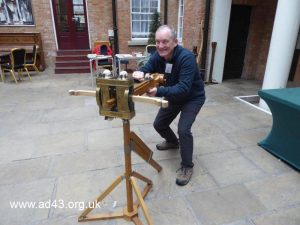 For those who were asking me about my recommended Roman fiction, there were several people that I remember, I recommend Steven Saylor, Simon Scarrow and Harry Sidebottom (apparently a surname beginning with ‘S’ is a prerequisite to write Roman fiction, as Rosemary Sutcliff is also worth a read) Away from the ‘S’s give Adrian Goldsworthy’s fiction a go, or (shameless self-promotion) you could always read mine (S. M. Porter – Echoes of the Eternal City). Away from Roman fiction I am now on a mission to go and read a Pratchett novel after Ernest Black recommended anything by Pratchett as a must read. I also have a long list of local beers to go and sample curtesy of a long conversation with Geoff Millar and Graeme Hempsall.
For those who were asking me about my recommended Roman fiction, there were several people that I remember, I recommend Steven Saylor, Simon Scarrow and Harry Sidebottom (apparently a surname beginning with ‘S’ is a prerequisite to write Roman fiction, as Rosemary Sutcliff is also worth a read) Away from the ‘S’s give Adrian Goldsworthy’s fiction a go, or (shameless self-promotion) you could always read mine (S. M. Porter – Echoes of the Eternal City). Away from Roman fiction I am now on a mission to go and read a Pratchett novel after Ernest Black recommended anything by Pratchett as a must read. I also have a long list of local beers to go and sample curtesy of a long conversation with Geoff Millar and Graeme Hempsall.
Other information:
A number of our lecturers have published material that we are delighted to promote.
Alan Wilkins brought copies of his latest work ‘Roman Imperial Artillery’ along for us to purchase. Something which I think most, if not all attendees did. For those of you who were unable to make it to the conference Alan’s book can be bought online here: http://romancatapults.co.uk/
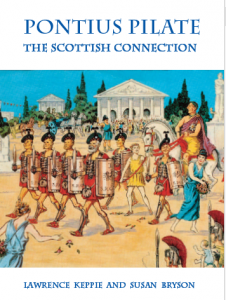
Lawrence Keppie is well known for his work on Pontius Pilate being from Scotland his booklet on this, ‘Pontius Pilate: The Scottish Connection’ is available from Glasgow Archaeological Society for £3 via [email protected]
Guy Stiebel’s new publication, “The Eagle and the Flies: Arms, Men and Society in Roman Judea” is due to be published before the end of this year.
Binchester Roman Fort
13th/14th July – Roma Antiqua and Barbaratus the cavalryman demonstrations of archery, slingshot and ballista
26th August – Roma Antiqua and Barabaratus the cavalryman demonstrate Roman weapons and fighting techniques
The Roman Military Research Society can be found online at www.romanarmy.net
They have a scheduled appearance at Chedworth Roman Villa on 3rd/4th August 2019
THE ROMAN ARMY SCHOOL 2019 LECTURE PROGRAMME:
Guy Stiebel – A Stone Throw … Artillery in Roman Judea
Jorit Wintjes – Roman Artillery on the Battlefield
Guy Stiebel – Masada Shall not Fall Again? News from the Battlefield
Lawrence Keppie – Getting Your Message Across: Inscribed Ballista Balls & Sling Bullets
Graham Sumner – Unleash Hell: The Roman Army on Screen
Alan Wilkins & Len Morgan – Catapult Research 1840-2019 Progress and Regress
Val Maxfield – Vespasian in Britain
David Breeze – Burnswark: Siege Training or Display?
Discussion
List of 2019 Roman Army School Delegates:
| Pat Barnes | Helen Gawthrop | Richard Law | Graham Sumner |
| Ernest Black | Michael Aram | Gill Law | Erika Trueman |
| Trevor Bloom | John Harding | Val Maxfield | Ed Valerio |
| David Breeze | Graeme Hempsall | Geoff Miller | Ineke Valerio |
| Christopher Banbury | Alfons Heyrman | Norma Miller | John Wall |
| Mark Corby | Peter Hill | Len Morgan | Alan Wilkins |
| Linda Davis | Steve Hunneysett | Kristian Myer | Margery Wilkins |
| Anne Dobson | Ray Hunneysett | Adrian Nayler | Jorit Wintjes |
| Heidi Donalson | Lawrence Keppie | Susan Porter | Ron Wood |
| Nick Elsden | Mike King Macdona | Graham Pude | |
| Christopher England | Kurt Kleeman | Peter Steele | |
| Pauline Gaskell | David Lakin | Guy Stiebel |
THE ROMAN ARMY SCHOOL 2020
27th March – 30th March 2020
The annual Roman Army School will meet at St Chad’s, Durham, in 2020. The subject of the meeting will be: Reconstructing Hadrian’s Wall (and other Roman forts)
After a successful 2019 meeting on Sieges and Artillery we will be turning our attention to what Hadrian’s Wall and Roman forts might have looked like. We will consider the evidence for reconstructions and look at three reconstructed buildings at South Shields. Speakers will include Dr Christof Fluegel, head of the Bavarian Museums Service, Peter Hill, formerly Clerk of Works at Lincoln Cathedral, Dr Louisa Campbell of Glasgow University on colouring inscriptions, Professor David Breeze and Professor Valerie Maxfield. Paul Bidwell and Nick Hodgson will lead the tour to South Shields fort as well as speaking at the conference.
HAVE YOUR SAY:
We at the Roman Army School want to provide an interesting and entertaining program of lectures each year. To do this we need a different theme to explore for each meeting and we’d love your input. Is there a specific topic that you would like to see us cover? Let us know, we are open to any and all new ideas.
CONTACT US:
The Roman Army School can be found online at www.ad43.org.uk
We are on Facebook @RomanArmySchool
We are on Twitter @RomanArmySchool
And you can contact us by email at [email protected]
